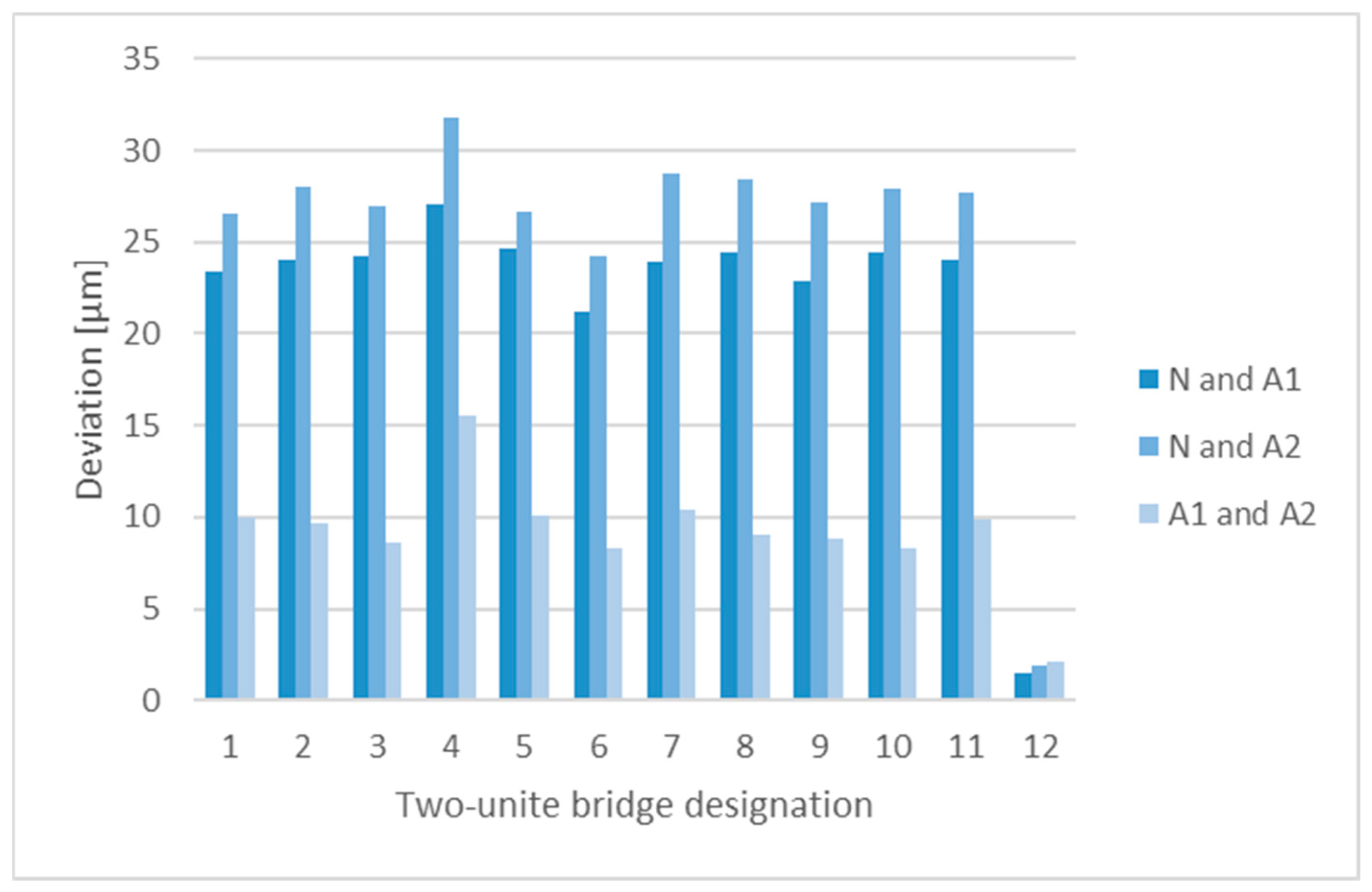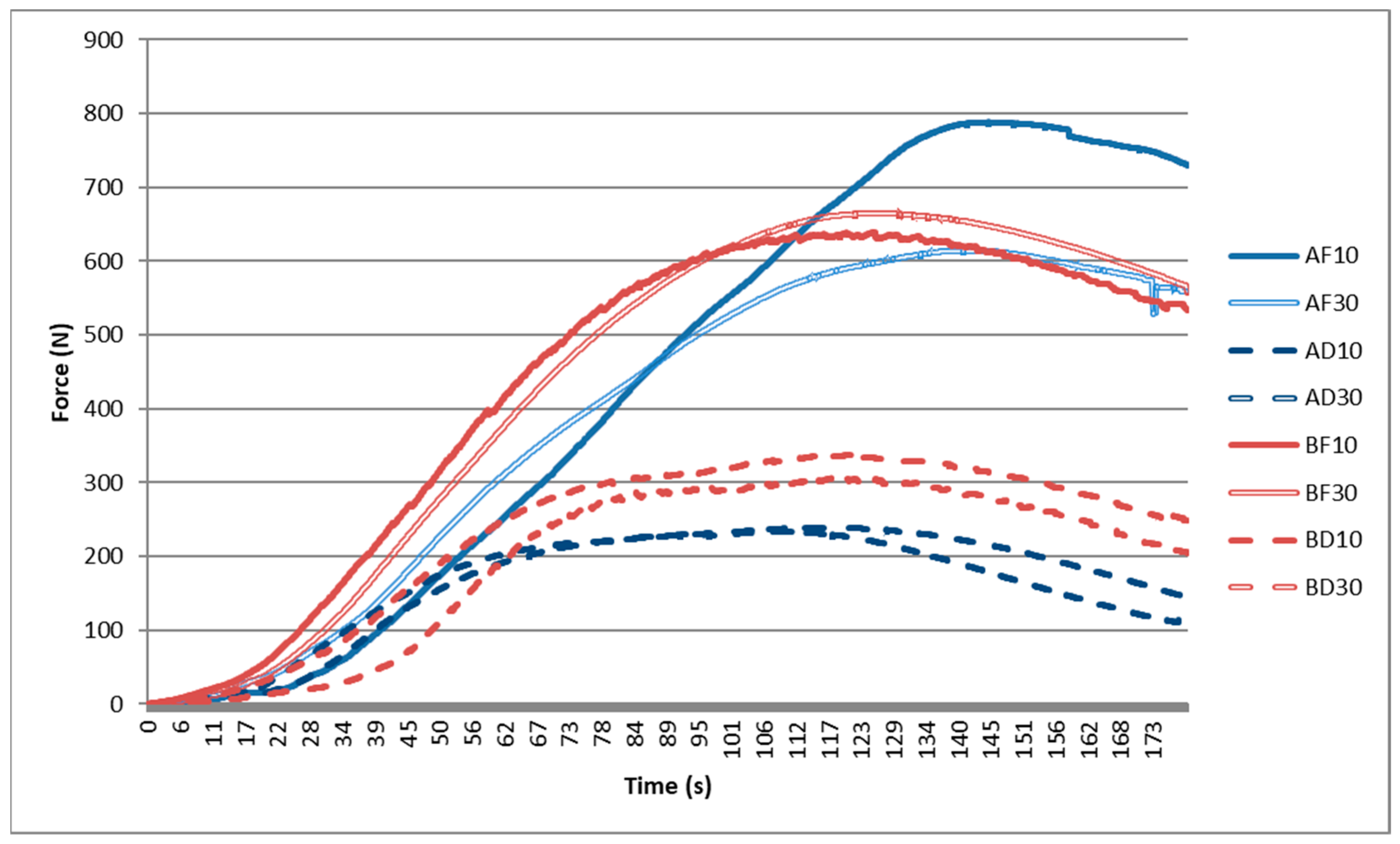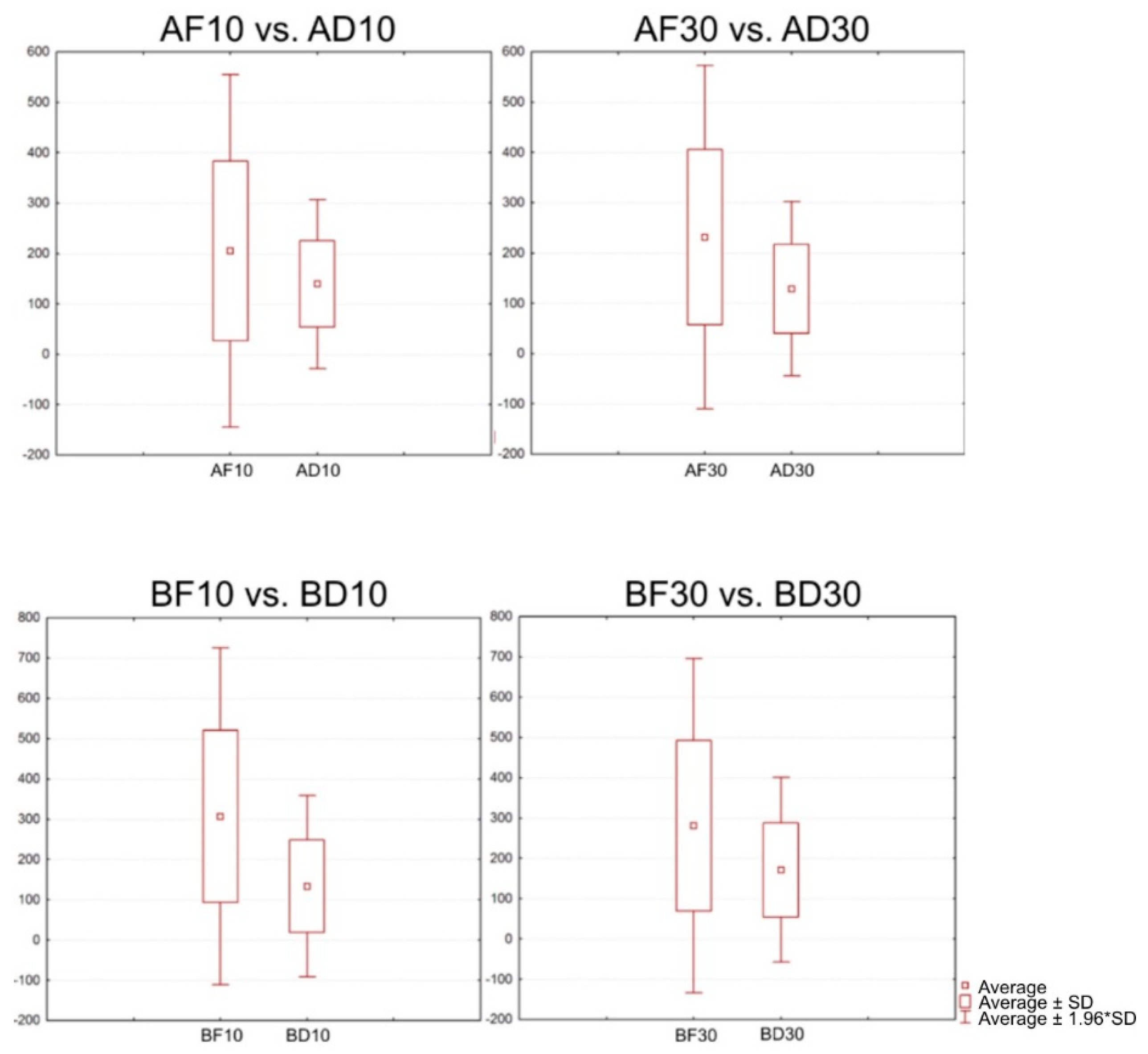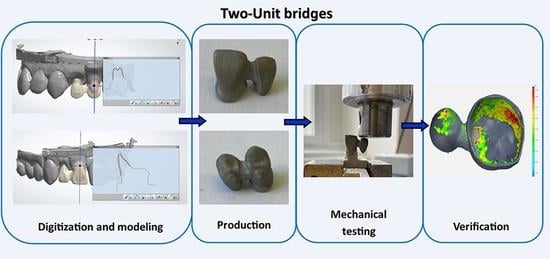Biomechanical Testing of Two-Unit Bridges and a Comparison of Replacement Retention Depending on a Cementation Medium, Replacement Position, and Gap Size
Abstract
1. Introduction
2. Materials and Methods
2.1. Designing and Modelling Two-Unit Bridges
2.2. Designing and Modelling Test Stumps
2.3. Material
2.4. Fabrication of Bridges and Test Stumps
2.5. Annealing and Its Effects on the Specimens
2.6. Mechanical Testing
3. Results
3.1. Preparation of Dental Test Specimens
3.2. Effects of Annealing on the Accuracy of the Two-Unit Bridges
- The modelled two-unit bridges (Nominal, N) and the model without annealing (Actual1, A1);
- The modelled two-unit bridges (Nominal, N) and the model after annealing (Actual2, A2);
- The model before annealing (Actual1, A1) and the model after annealing (Actual2, A2).
3.3. Evaluation of Mechanical Compressive Testing
3.4. Statistical Evaluation of the Effect of a Specimen Type on Strength
3.5. Comparison of the Cement Types
3.6. Comparison of the Positions of the Two-Unit Bridges
3.7. Effects of the Sizes of Gaps in the Two-Unit Bridges
4. Discussion
5. Conclusions
Author Contributions
Funding
Institutional Review Board Statement
Informed Consent Statement
Data Availability Statement
Acknowledgments
Conflicts of Interest
References
- Dolgov, N.A.; Dikova, T.; Dzhendov, D.; Pavlova, D.; Simov, M. Mechanical properties of dental Co-Cr alloys fabricated via casting and Selective Laser Melting. Mater. Sci. Non-Equilib. Phase Transform. 2016, 2, 3–7. [Google Scholar]
- Herranz, G.; Berges, C.; Naranjo, J.A.; García, C.; Garrido, I. Mechanical performance, corrosion and tribological evaluation of a Co–Cr–Mo alloy processed by MIM for biomedical applications. J. Mech. Behav. Biomed. Mater. 2020, 105, 103706. [Google Scholar] [CrossRef] [PubMed]
- Ammarullah, M.I.; Santoso, G.; Sugiharto, S.; Supriyono, T.; Kurdi, O.; Tauviqirrahman, M.; Winarni, T.I.; Jamari, J. Tresca stress study of CoCrMo-on-CoCrMo bearings based on body mass index using 2D computational model. J. Tribol. 2022, 33, 31–38. [Google Scholar]
- Viderščak, D.; Schauperl, Z.; Šolić, S.; Ćatić, A.; Godec, M.; Kocijan, A.; Paulin, I.; Donik, Č. Additively Manufactured Commercial Co-Cr Dental Alloys: Comparison of Microstructure and Mechanical Properties. Materials 2021, 14, 7350. [Google Scholar] [CrossRef]
- Quante, K.; Ludwig, K.; Kern, M. Marginal and internal fit of metal-ceramic crowns fabricated with a new laser melting technology. Dent. Mater. 2008, 24, 1311–1315. [Google Scholar] [CrossRef]
- Torabi, K.; Farjood, E.; Hamedani, S. Rapid Prototyping Technologies and their Applications in Prosthodontics, a Review of Literature. J. Dent. 2015, 16, 1–9. [Google Scholar]
- Sadid-Zadeh, R.; Katsavochristou, A.; Squires, T.; Simon, M. Accuracy of marginal fit and axial wall contour for lithium disilicate crowns fabricated using three digital workflows. J. Prosthet. Dent. 2020, 123, 121–127. [Google Scholar] [CrossRef]
- Schaefer, O.; Kuepper, H.; Thompson, G.A.; Cachovan, G.; Hefti, A.F.; Guentsch, A. Effect of CNC-milling on the marginal and internal fit of dental ceramics: A pilot study. Dent. Mater. 2013, 29, 851–858. [Google Scholar] [CrossRef]
- Colpani, J.T.; Borba, M.; Della Bona, Á. Evaluation of marginal and internal fit of ceramic crown copings. Dent. Mater. 2013, 29, 174–180. [Google Scholar] [CrossRef]
- Riccitiello, F.; Amato, M.; Leone, R.; Spagnuolo, G.; Sorrentino, R. In vitro Evaluation of the Marginal Fit and Internal Adaptation of Zirconia and Lithium Disilicate Single Crowns: Micro-CT Comparison Between Different Manufacturing Procedures. Open Dent. J. 2018, 12, 160–172. [Google Scholar] [CrossRef]
- Sampaio, C.S.; Barbosa, J.M.; Cáceres, E.; Rigo, L.C.; Coelho, P.G.; Bonfante, E.A.; Hirata, R. Volumetric shrinkage and film thickness of cementation materials for veneers: An in vitro 3D microcomputed tomography analysis. J. Prosthet. Dent. 2017, 117, 784–791. [Google Scholar] [CrossRef] [PubMed]
- Musleh, A.M.; AbuNasser, B.S.; Faraj, A.J.; Awwad, A.; Hamad, Y.J.; Al Hour, F.; Elshanti, A. Evaluation of Marginal Gap and Internal Adaptation of All-Ceramic Coping Fabricated With CAD/CAM and Press-Laboratory Technique; an In Vitro Study. 2020. Available online: http://dspace.alazhar.edu.ps/xmlui/handle/123456789/642 (accessed on 15 September 2020).
- Yun, M.-J.; Jeon, Y.-C.; Jeong, C.-M.; Huh, J.-B. Comparison of the fit of cast gold crowns fabricated from the digital and the conventional impression techniques. J. Adv. Prosthodont. 2017, 9, 1–13. [Google Scholar] [CrossRef] [PubMed]
- Alqahtani, F. Marginal fit of all-ceramic crowns fabricated using two extraoral CAD/CAM systems in comparison with the conventional technique. Clin. Cosmet. Investig. Dent. 2017, 9, 13–18. [Google Scholar] [CrossRef]
- Farjood, E.; Vojdani, M.; Torabi, K.; Khaledi, A.A.R. Marginal and internal fit of metal copings fabricated with rapid prototyping and conventional waxing. J. Prosthet. Dent. 2017, 117, 164–170. [Google Scholar] [CrossRef] [PubMed]
- Javaid, M.; Haleem, A. Current status and applications of additive manufacturing in dentistry: A literature-based review. J. Oral Biol. Craniofacial Res. 2019, 9, 179–185. [Google Scholar] [CrossRef]
- Bhargav, A.; Sanjairaj, V.; Rosa, V.; Feng, L.W.; Fuh, Y.H. Applications of additive manufacturing in dentistry: A review. J. Biomed. Mater. Res. Part B Appl. Biomater. 2018, 106, 2058–2064. [Google Scholar] [CrossRef] [PubMed]
- Qian, B.; Saeidi, K.; Kvetková, L.; Lofaj, F.; Xiao, C.; Shen, Z. Defects-tolerant Co-Cr-Mo dental alloys prepared by selective laser melting. Dent. Mater. 2015, 31, 1435–1444. [Google Scholar] [CrossRef]
- Koutsoukis, T.; Zinelis, S.; Eliades, G.; Al-Wazzan, K.; Rifaiy, M.A.; Al Jabbari, Y.S. Selective laser melting technique of Co-Cr dental alloys: A review of structure and properties and comparative analysis with other available techniques. J. Prosthodont. 2015, 24, 303–312. [Google Scholar] [CrossRef]
- Bae, E.J.; Jeong, I.D.; Kim, W.C.; Kim, J.H. A comparative study of additive and subtractive manufacturing for dental restoration. J. Prosthet. Dent. 2017, 118, 187–193. [Google Scholar] [CrossRef]
- Braian, M.; Jönsson, D.; Kevci, M.; Wennerberg, A. Geometrical accuracy of metallic objects produced with additive or subtractive manu-facturing: A comparative in vitro study. Dent. Mater. 2018, 34, 978–993. [Google Scholar] [CrossRef]
- Han, X.; Sawada, T.; Schille, C.; Schweizer, E.; Scheideler, L.; Geis-Gerstorfer, J.; Rupp, F.; Spintzyk, S. Comparative analysis of mechanical properties and metal-ceramic bond strength of Co-Cr dental alloy fabricated by different manufacturing processes. Materials 2018, 22, 11. [Google Scholar] [CrossRef] [PubMed]
- Zhou, Y.; Li, N.; Yan, J.; Zeng, Q. Comparative analysis of the microstructures and mechanical properties of Co-Cr dental alloys fabricated by different methods. J. Prosthet. Dent. 2018, 120, 617–623. [Google Scholar] [CrossRef] [PubMed]
- Pereira, T.; Kennedy, J.V.; Potgietber, J. A comparison of traditional manufacturing vs additive manufacturing, the best method for the job. Procedia Manuf. 2019, 30, 11–18. [Google Scholar] [CrossRef]
- Duda, T.; Venkat Raghavan, L. 3D metal printing technology. IFAC-Pap. 2016, 49, 103–110. [Google Scholar] [CrossRef]
- Powers, J.M.; Wataha, J.C.; Chen, Y.-W. Dental materials foundations and applications. J. Tek. 2017, 8, 85–88. [Google Scholar]
- Phunthikaphadr, T.; Takahashi, H.; Arksornnukit, M. Pressure transmission and distribution under impact load using artificial denture teeth made of different materials. J. Prosthet. Dent. 2009, 102, 319–327. [Google Scholar] [CrossRef]
- Koc, D.; Dogan, A.; Bek, B. Bite Force and Influential Factors on Bite Force Measurements: A Literature Review. Eur. J. Dent. 2010, 4, 223–232. [Google Scholar] [CrossRef]
- Anusavice, K.J.; Shen, C.; Rawls, H.R. (Eds.) Phillip’s Science of Dental Materials Health Sciences; Elsevier: Amsterdam, The Netherlands, 2013. [Google Scholar]
- Ajay, R.; Suma, K.; Ali, S.A.; Sivakumar, J.S.K.; Rakshagan, V.; Devaki, V.; Divya, K. Effect of Surface Modifications on the Retention of Cement-retained Implant Crowns under Fatigue Loads: An In vitro Study. J. Pharm. Bioallied Sci. 2017, 9, S154–S160. [Google Scholar] [CrossRef]
- Taha, Y.; Raslan, F.; Ali, A.; Roig, M. Guided tooth preparation device fabricated with a complete digital workflow: A dental technique. J. Prosthet. Dent. 2021, 125, 221-e1. [Google Scholar] [CrossRef]
- Abad-Coronel, C.; Naranjo, B.; Valdiviezo, P. Adhesive Systems Used in Indirect Restorations Cementation: Review of the Literature. Dent. J. 2019, 7, 71. [Google Scholar] [CrossRef]
- Brondani, L.P.; Pereira-Cenci, T.; Wandsher, V.F.; Pereira, G.K.; Valandro, L.F.; Bergoli, C.D. Longevity of metal-ceramic crowns cemented with self-adhesive resin cement: A prospective clinical study. Braz. Oral Res. 2017, 31, 1–6. [Google Scholar] [CrossRef] [PubMed]
- Podrez-Radziszewska, M.; Haimann, K.; Dudziński, W.; Morawska-Sołtysik, M. Characteristic of intermetallic phases in cast dental CoCrMo alloy. Arch. Foundry Eng. 2010, 10, 51–56. [Google Scholar]
- Ayesha, N.; Ali, S.M.S.; Shastry, Y.M.; Reddy, K.M. A Comparative Assessment of Bond Strength of PEEK Crowns to Natural Teeth with Two Different Resin Cements. Int. J. Dent. Med. 2020, 6, 7. [Google Scholar] [CrossRef]









| Mechanical Property | Value |
|---|---|
| Yield strength (Rp0.2) | 760 MPa |
| Tensile strength | 1090 MPa |
| Relative elongation at break | 15% |
| Module of elasticity | 225 GPa |
| Vickers hardness | 425 HV 10 |
| Type (DIN EN ISO 22674) | Class 5 |
| Material | Module of Elasticity [GPa] |
|---|---|
| Ceramill PEEK (Amann Girrbach, Austria) | 4 |
| Ceramill Zolid (Amann Girrbach, Austria) | >200 |
| Starbond Easy CoCr Powder (Scheftner Dental, Germany) | 225 |
| Enamel | 80 |
| Dentin | 18.6 |
| Cortical bone | 13.7 |
| Spongy bone | 1.37 |
| Designation | ||
|---|---|---|
| Cement Type | Zinc polycarboxylate | A |
| Zinc phosphate | B | |
| Position | Frontal | F |
| Distal | D | |
| Gap size | 10 μm | 10 |
| 30 μm | 30 |
| Group 1 (S1) | Group 2 (S2) | Average S1 | Average S2 | t Value | p | Standard Deviation S1 | Standard Deviation S2 | F-Ratio Dispersion | P Dispersion |
|---|---|---|---|---|---|---|---|---|---|
| AF10 | BF10 | 204.75 | 306.77 | −25.94 | 0.00 | 178.44 | 213.32 | 1.43 | 0.00 |
| AF30 | BF30 | 231.63 | 281.3 | −12.81 | 0.00 | 173.95 | 211.77 | 1.48 | 0.00 |
| AD10 | BD10 | 139.38 | 133.37 | 2.97 | 0.003 | 85.55 | 114.88 | 1.80 | 0.00 |
| AD30 | BD30 | 128.77 | 171.19 | −20.45 | 0.00 | 88.40 | 117.04 | 1.75 | 0.00 |
| Group 1 (S1) | Group 2 (S2) | Average S1 | Average S2 | t Value | p | Standard Deviation S1 | Standard Deviation S2 | F-Ratio Dispersion | P Dispersion |
|---|---|---|---|---|---|---|---|---|---|
| AF10 | AD10 | 204.75 | 139.38 | 23.36 | 0.00 | 178.44 | 85.55 | 4.35 | 0.00 |
| AF30 | AD30 | 231.63 | 128.77 | 37.27 | 0.00 | 173.95 | 88.40 | 3.87 | 0.00 |
| BF10 | BD10 | 306.77 | 133.37 | 50.61 | 0.00 | 213.32 | 114.88 | 3.45 | 0.00 |
| BF30 | BD30 | 281.29 | 171.19 | 32.18 | 0.00 | 211.77 | 117.04 | 3.27 | 0.00 |
| Group 1 (S1) | Group 2 (S2) | Average S1 | Average S2 | t Value | p | Standard Deviation S1 | Standard Deviation S2 | F-Ratio Dispersion | P Dispersion |
|---|---|---|---|---|---|---|---|---|---|
| AF10 | AD10 | 204.75 | 231.63 | −7.63 | 0.00 | 178.44 | 173.95 | 1.05 | 0.07 |
| AF30 | AD30 | 139.38 | 128.77 | 6.09 | 0.00 | 85.55 | 88.40 | 1.07 | 0.02 |
| BF10 | BD10 | 306.77 | 281.29 | 5.99 | 0.00 | 213.32 | 211.77 | 1.01 | 0.61 |
| BF30 | BD30 | 133.36 | 171.19 | −16.31 | 0.00 | 114.88 | 117.04 | 1.04 | 0.19 |
Publisher’s Note: MDPI stays neutral with regard to jurisdictional claims in published maps and institutional affiliations. |
© 2022 by the authors. Licensee MDPI, Basel, Switzerland. This article is an open access article distributed under the terms and conditions of the Creative Commons Attribution (CC BY) license (https://creativecommons.org/licenses/by/4.0/).
Share and Cite
Findrik Balogová, A.; Rajťúková, V.; Chromý, Ľ.; Somoš, A.; Ižaríková, G.; Hudák, R. Biomechanical Testing of Two-Unit Bridges and a Comparison of Replacement Retention Depending on a Cementation Medium, Replacement Position, and Gap Size. J. Funct. Biomater. 2022, 13, 286. https://doi.org/10.3390/jfb13040286
Findrik Balogová A, Rajťúková V, Chromý Ľ, Somoš A, Ižaríková G, Hudák R. Biomechanical Testing of Two-Unit Bridges and a Comparison of Replacement Retention Depending on a Cementation Medium, Replacement Position, and Gap Size. Journal of Functional Biomaterials. 2022; 13(4):286. https://doi.org/10.3390/jfb13040286
Chicago/Turabian StyleFindrik Balogová, Alena, Viktória Rajťúková, Ľuboš Chromý, Andrej Somoš, Gabriela Ižaríková, and Radovan Hudák. 2022. "Biomechanical Testing of Two-Unit Bridges and a Comparison of Replacement Retention Depending on a Cementation Medium, Replacement Position, and Gap Size" Journal of Functional Biomaterials 13, no. 4: 286. https://doi.org/10.3390/jfb13040286
APA StyleFindrik Balogová, A., Rajťúková, V., Chromý, Ľ., Somoš, A., Ižaríková, G., & Hudák, R. (2022). Biomechanical Testing of Two-Unit Bridges and a Comparison of Replacement Retention Depending on a Cementation Medium, Replacement Position, and Gap Size. Journal of Functional Biomaterials, 13(4), 286. https://doi.org/10.3390/jfb13040286









